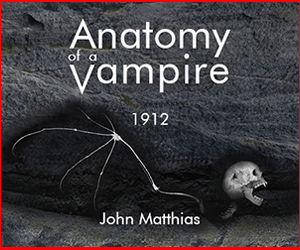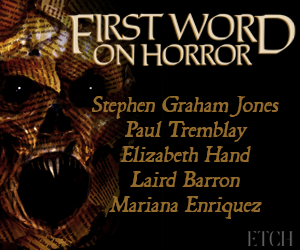“Something’s touching me . . . !”
If you watch any of the paranormal “reality” television series (yes, I’ve deliberately put “reality” into quotation marks), you’ve probably heard someone say this (followed by the requisite music stab). It’s a great line because it’s completely subjective, impossible to either confirm or deny, so no pesky evidence is required. Of course these series will also present “evidence” (yes, quotation marks again), which usually take the form of a blurry photograph of shadows in a dark room or an undecipherable sound caught in an EVP (electronic voice phenomenon) recording.
With the 2004 debut of the series Ghost Hunters, the idea of the intrepid paranormal researcher armed with gadgets like K2 meters (to read energy spikes) and infrared cameras firmly took hold of our consciousness. There were cinematic forerunners—see Ghostbusters (1984) and The Stone Tape (1972) for what I believe are the most important influences on the modern paranormal investigation—but the earliest and best examples of spirit seekers are found in literature.
We could suggest that Homer modeled the ghost-summoning scene in The Odyssey (when Odysseus stands at the mouth of Hades and calls up a host of spirits) after something real, but the first heavily documented case of a real haunting that we can be sure of was probably in 1661, when “the Drummer of Tedworth” took England by storm. After hearing about numerous witnesses to this extremely active haunting, a respected writer and clergyman named Joseph Glanvill took it upon himself to investigate. Reverend Glanvill spent days interviewing those involved and staying in the large English manor house at the center of the story, viewing the reports and activity as dispassionately as possible; he eventually published his detailed accounts in the book Saducismus Triumphatus, which led to multiple editions, spin-offs and a copycat American drummer. Many now refer to Glanvill as the first paranormal investigator.
Ghost stories in fiction really got their start with the publication of Horace Walpole’s Gothic classic The Castle of Otranto (1764), but these early spooky tales relied not on science but on history or hoaxes (certain writers like Ann Radcliffe were so reluctant to give any credence to ghosts in reality that they explained their hauntings as scams even in fiction). In 1848, two teenage girls, Kate and Maggie Fox, began communicating with spirits in their New York farmhouse and inaugurated both the séance and the religion of Spiritualism, which was unique in believing itself to be the only religion that could be proven scientifically (it didn’t seem to matter to Spiritualists that mediums were more often debunked than authenticated). Science was also progressing by leaps and bounds in the nineteenth century, and many of the great scientists took an interest in investigating claims of mediumship and ghostly occurrences. Some, like the great Sir William Crookes, even concluded that most of the mediums were genuine.
Strangely, fiction lagged behind when it came to science. Ghost stories of the period too often fell into the tried-and-true model of the lone witness to some ethereal happening, whether a haunted house or a ghost train. Spiritualists who also wrote fiction might incorporate mediums and séances into their work, but they avoided science. Even after the Society for Psychical Research (SPR) was born in 1882, ghost stories continued to present their supernatural goings-on apart from any serious investigation.
It took the arrival of a literary giant to inaugurate a more scientific approach to literary ghosts: Sir Arthur Conan Doyle’s Sherlock Holmes. Although Holmes himself wasn’t much interested in the undead (although his creator was an ardent Spiritualist), by the end of the nineteenth century the world was mad for detective stories and 1898 saw the publication of the first psychic detective story: “The Story of the Spaniards, Hammersmith.” Written by the mother and son team of H. Heron and E. Heron (Hesketh Vernon Prichard and Kate Prichard), this harbinger paved the way for William Hope Hodgson’s “Carnacki the Ghost Finder” tales and took fictitious ghost-hunting in a new direction.
By the middle of the twentieth century, breakthrough photographic and audio recording technologies were leading to things like the first EVP recordings and new theories regarding ghosts and energy, and horror fiction began to mesh science and spirits more often. In the 1980s, blockbuster films like Poltergeist and Ghostbusters birthed a renewed public interest in parapsychology. With the twenty-first-century explosion of ghost-hunting reality series, paranormal investigation was finally brought home; now anyone could own a cheap handheld device that would theoretically detect ghost energies or use a phone to record a spirit’s whispered messages.
With the renaissance of great horror writing over the last decade, exciting new voices are putting fresh spins on this subgenre of the ghost story that’s now more than a century old.
RECOMMENDED READING
“The Story of the Spaniards, Hammersmith” by H. Heron and E. Heron
Maybe I’m cheating by beginning this list with a short story, but, as noted above, this one really kicked off the whole idea of fictitious ghost investigations. No longer was the protagonist of a ghost story a domestic worker who is abruptly transported to a haunted location or a curiosity seeker who gets more than they bargained for. No, the hero of this piece, Flaxman Low, is a brilliant investigator who is called upon by friends to look into their haunted house, where he observes and puts facts together to reveal the nature of the mysterious entity. While he doesn’t employ equipment (Flaxman Low is much more in the mold of Sherlock Holmes, instead relying on observation and deduction), he nevertheless approaches the haunting with scientific curiosity and creates a very entertaining tale in the process (with a unique ghost). Originally published in Pearson’s Magazine #25 for January 1898, this story led to a series of Flaxman Low stories that was published in 1899 as Ghosts: Being the Experiences of Flaxman Low (which can be read free online: bit.ly/3Kp3VGt.)
The Haunting of Hill House by Shirley Jackson
Not including this book in a list of works about ghost investigations would be like not including Dracula in a list of vampire novels. This is the absolute quintessential novel about a paranormal investigation.
First published in 1959, The Haunting of Hill House is a still-resonating atomic blast in the history of horror literature. At a time when most horror aspired to little more than getting a reader to plunk down a few coins for a solid pulp adventure, Jackson infused a ghost story with not just contemporary parapsychology but also with literate style. By now, after multiple movie and television adaptations, most of us know the story of the four-person team organized by Dr. John Montague to investigate the haunted Hill House. Because Montague has chosen his crew on the basic of either anomalous happenings (the sheltered Eleanor) or ESP skill (the larger-than-life Theodora), Montague echoes the real-life J. B. Rhine, who founded the Duke University Parapsychology Lab in 1927.
Hell House by Richard Matheson
Released in 1971, Matheson’s novel may be reminiscent of The Haunting of Hill House in its structure—it also follows a quartet investigating a famously haunted house—but Matheson brought the ghost story into the modern era of horror by upping the sex and gore via his antagonist Emeric Belasco, the evil original owner of the house. Matheson also incorporated things straight out of the SPR playbook like ectoplasm, a whitish material supposedly exuded by some mediums.
The Entity by Frank de Felitta
The Entity is unique on this list as being the only one of my choices that was based on a real case, that of housewife Doris Bither, who was investigated in 1974 by UCLA Parapsychology Lab’s Barry Taff and Kerry Gaynor. In de Felitta’s 1978 novel, single mother Carla Moran is sexually assaulted by an unseen entity and eventually seeks the help of parapsychologists in freeing her from the invisible tormentor. The Entity takes the science part of parapsychology farther than any other book on this list as the scientists attempt to recreate Carla’s house in a controlled environment where they hope to capture the spirit. Side personal note: I met Doris Bither at a screening of the film adaptation of The Entity in 1982, and she told me that the entity still messed with her but kept its visitations confined to opening drawers and moving small objects.
The Spite House by Johnny Compton
Over the last half-decade, the haunted house novel has been reinvigorated by a new generation of horror writers who’ve investigated the old tropes from their own diverse viewpoints. Although many of these works don’t directly deal with paranormal investigations, Johnny Compton’s The Spite House (2023) includes a failed paranormal investigation in its backstory. Interweaving two interconnecting family dramas with racism and a haunted “spite house”—a structure built for no better reason than to piss somebody off—Compton’s investigators are out of the picture before the arrival of his protagonist, a single father on the run who becomes the caretaker to the dangerous residence.
The Spite House, in fact, could be said to carry on the fine tradition of paranormal investigators who go mad or die in horrible ways (Flaxman Low notwithstanding). Some things, so these stories tell us, are best left uninvestigated lest we be touched in ways that may lead to more than music stabs.








